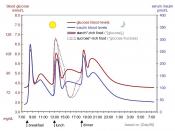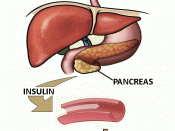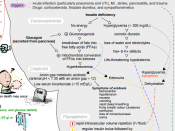DIABETIC KETOACIDOSIS
PATHOPHYSIOLOGY
Diabetic Ketoacidosis (DKA) is serious condition characterized by high blood glucose, dehydration, nausea and vomiting, and the presence of ketones. Ketones are made when your body burns fat instead of glucose for energy. This occurs when there is not enough insulin. It usually occurs in patients with Type 1 diabetes, but can develop in patients with Type 2 diabetes as well. DKA may be the initial manifestation of previously unrecognized Type 1 diabetes. Most commonly it develops in patients who fail to take their insulin or who do not receive extra insulin during stress (infection, heart attack, surgery). A common misconception, by physicians and patients, is that if a patient with Type 1 diabetes is not going to eat, that he or she should not take any insulin. The mortality associated with DKA is less than 5%. Ketoacidosis is common caused by not taking insulin, infection, new onset of type 1 diabetes, and leaving insulin at 80 degrees or higher, or letting the insulin freeze.
SIGNS AND SYMPTOMS
*Dry mouth
*Great thirst
*Fruity breath
*Loss of appetite
*Stomach pain
*Nausea
*Fever (can be absent)
*Fatigue
*Drowsiness
*Frequent urination
*Labored breathing
*Vomiting
Medical Treatment
The goal of treatment is to correct the elevated blood-glucose level by the administration of additional insulin, and replace fluids lost through excessive urination and vomiting. Often, a person with diabetes will be able to recognize the early warning signs and make appropriate corrections at home before the condition progresses to coma.
If ketoacidosis is severe, hospitalization is required to control the condition. Insulin replacement will be given, fluid and electrolytes will be replaced, and the cause of the condition (such as infection) will be identified and treated.
NURSING DIAGNOSIS
*Altered nutrition
*Altered urinary elimination
*Fluid volume deficit
NURSING INTERVENTIONS
Keep accurate...


